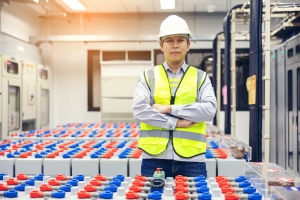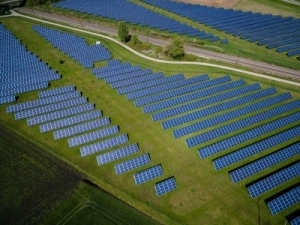UK company utilizes depleted uranium to store H2
A company based in the UK is using depleted uranium to store hydrogen.
A collaboration from the United Kingdom has been awarded approximately 8 million pounds to fund the development of a technological demonstration for long-term hydrogen storage that uses depleted uranium as a conduit.
EDF UK, Bristol University, the UK Atomic Energy Authority, and Urenco will be working together on the HyDUS (Hydrogen in Depleted Uranium Storage) pilot project. The group will hold hydrogen in the form of reversible metal hydrides, which will then be absorbed into a "bed" of depleted uranium, releasing the hydrogen once again when the bed is heated. The Department of Business, Energy, and Industrial Strategy's (BEIS) Net Zero Innovation Portfolio (NZIP) provided funding for £7.7 million for the project, a component of the Longer Duration Energy Storage demonstration program at the UKAEA's Culham Campus near Oxford.
Professor Tom Scott from Bristol University's School of Physics, one of the architects of the HyDUS technology, noted that "This will be a global first technology demonstration which is a stunning and exciting translation of a well-proved fusion-fuel hydrogen isotope storage technology that the UK Atomic Energy Authority has employed for several decades at a modest scale." "This will be a world-first technology demonstrator, which is a beautiful and exciting translation of a well-established fusion-fuel hydrogen isotope storage technology
" The hydride compounds that we are exploiting are capable of chemically storing hydrogen at the same pressure and temperature as is found in the surrounding environment. What's more remarkable is that they can accomplish this at a density which is twice to that of liquid hydrogen." The hydrogen may be released from the material rapidly by merely heating it, making it an excellently reversible method for storing hydrogen.
Integrating an increasing amount of renewable and low-carbon energy sources into the UK's electricity network will make grid resilience and flexibility increasingly important. Electrolysis is a method that might be used to manufacture hydrogen through the usage of extra electricity available on the grid, usually occurring overnight. Hydrogen, on the other hand, is challenging to store, particularly for extended amounts of time. Better options for long-term hydrogen storage are consequently considered crucial for a future hydrogen economy, which many people view as vital for the shift to cleaner forms of energy.
As the director of research and development for EDF, Patrick Dupeyrat, stated, "The novel form of long endurance energy storage that will be illustrated in HyDUS has excellent efficiencies with the nuclear supply chain and EDF's power stations, particularly within a prospective low-carbon electricity system, where flexibility utilizing hydrogen would then play an important role."
"I am particularly delighted to watch the demonstration phase of this fascinating technology and the cooperation among all of our major partners," said the speaker.
Pillswood energy storage goes into service using Tesla Megapacks
In England, a battery energy storage system claimed to be among the biggest in Europe has been put into operation.
The Pillswood project, located close to Hull and developed by Harmony Energy Limited, can store up to 196 MWh of power in a single cycle thanks to a Tesla two-hour Megapack system.
It is anticipated that the project would allow the substitution of fossil fuels with renewable power while also providing balancing services to the electrical grid network in the United Kingdom.
This connection point is planned for phases "A" and "B" of the Dogger Bank wind farm, which is scheduled to begin operations the following summer. The property in question is located near the Creyke Beck substation owned by National Grid.
Tesla oversaw all aspects of the development of the Pillswood project. Initially, it was anticipated that the project would enter operation in two stages, in December 2022 & March 2023, respectively. The schedule was sped up so that both phases could be energized in November, just in time to assist National Grid in its attempts to deliver consistent and secure electricity to families in the United Kingdom during what is anticipated to be a brutal winter.
Because of Russia's continuous aggression against Ukraine, the natural gas supply has been disrupted throughout Europe, which has a knock-on effect on energy generation across the continent.
The project will be overseen by Autobidder, Tesla's algorithmic trading platform. Autobidder has previously handled the Holes Bay and Contego projects, two different battery storage facilities that Harmony Energy Limited, in partnership with FRV, also created. Autobidder will be used to administer the project.
According to Harmony Energy Income Trust, Pillswood is the first of six comparable projects the Trust will deliver in the following year.
2020 and 2021 were both banner years for implementing solar energy in business settings. This growing pattern came to a complete and abrupt stop during the first half of 2022 due to issues in the supply chain, trade conflicts, and residual interruptions associated with pandemics.
The Solar Energy Industries Association (SEIA) recently published a market analysis indicating that commercial solar deployment reached a total of 1.7 GW between 2020 and 2021. Offsite projects accounted for more than three-quarters of that total.
However, a blend of commercial considerations, increased costs, and a limited supply of personnel and materials have led to delays in the completion of projects, most notably those using offsite solar.
As a direct consequence, offsite installations up to June were "far off the pace planned in 2021," according to SEIA, with "many 2022 projects extending functional dates to 2023 or beyond."
During the year's first half, there was an increase of less than 1.5 GW in total commercial solar capacity. Over five gigawatts worth of capacity were added over the whole year of 2021.
The delay is noteworthy given that the SEIA reported that more than half of the 19 GW of corporate solar installed so far had been built since 2020.
According to a statement made by an industry trade association, one of the critical factors that have led to an increase in the number of commercial solar installations during the last decade has been a continuous drop in the price of solar energy. Since 2012, the company's dataset has onsite project examples in which the cost of installing a commercial system has decreased by 51%.
According to the research, increasing module pricing is primarily the result of regulatory trade measures, which have decreased module imports' availability and raised module prices. This has led to increased module pricing.
PPA costs for all utility-scale projects have been in the range of $16–$35/MWh in recent years, reflecting a decline in pricing for offsite systems.
In contrast to these general tendencies, however, commercial solar costs in two of the three size categories SEIA monitors have increased over the last year. According to what was found, prices for systems with more than one-megawatt capacity and less than one hundred kilowatts are at their highest point since 2019 and 2018, respectively.
It was said that installers are witnessing higher module price due mainly to regulatory trade measures that have restricted the availability of module imports and raised module costs. As a result, increased module pricing has been seen by installers.
Inflation on a global scale has also contributed to a rise in the price of hardware. Meanwhile, labor prices have increased "substantially" due to rising demand and following what the SEIA referred to as "structural changes in the U.S. labor force" brought on by the Covid-19 epidemic.
The conclusions of the analysis were derived from data collected at the system level from over 48,000 commercial solar systems. These systems accounted for approximately 70% of the total installed capacity as of June.
Expanding of the ground mounts
According to the research, most systems use roof mounting techniques; however, ground installations are becoming increasingly frequent as system sizes rise. It was reported that around 23% of systems employ ground mounting equipment, an increase from 16% at the end of 2018.
In addition, it was said that more than 94% of offsite corporate capacity employs single-axis trackers, following the trend away from fixed-tilt systems that have been going on for the last decade. Fixed-tilt systems are primarily used in smaller offsite systems that cannot justify the extra expenditure of adding trackers due to a lack of economies of scale.
Executives of companies
According to the Solar Means Business 2022 study, commercial solar capacity in the United States presently accounts for 14% of the total solar capacity deployed. It identified Microsoft, Amazon, Apple, and Walmart as the top five corporate solar energy consumers in the United States.
Early in 2019, Meta's installed solar capacity was 177 megawatts (MW), but it has since climbed to 3.6 gigawatts (GW). Target has maintained its position as the largest onsite corporate solar customer, while Microsoft has into the top 10 by adding 479 MW of additional capacity since 2019.
According to the survey, Walmart's combination of onsite and offsite solar installations has maintained the company in the top five over the last decade. As of 2021, around 46 percent of the world's need for power was met by renewable sources.
According to the research, Microsoft has added 479 MW of additional capacity since 2019.
According to the article, many major corporations, including Intel, Google, Switch, and Digital Realty, have begun implementing solar power systems inside their respective data center buildings. In addition, corporations involved in the food and beverage industry, such as Ab Inbev and Starbucks, corporations involved in health care, such as Kaiser Permanente and DaVita, and other notable brands, such as Home Depot and T-Mobile, were ranked among the top 25 corporate consumers of solar energy.
Based on the survey, nearly 2 GW of the 10 GW of offsite commercial solar installations is located in Virginia, where the need from technology businesses and data centers is driving the majority of the demand. Commercial solar power was used most extensively by Amazon, Meta, Microsoft, Apple, and Digital Realty in this state.
According to the research, the number of U.S. enterprises that have installed at least 100 MW of solar power has increased to 23, up from 11 companies in 2019. Eighteen of the top 25 organizations rated in the survey are working toward using only renewable energy or being carbon neutral.
How about some growth?
As per SEIA, the total number of business solar installations is anticipated to quadruple once more over the following three years. Almost 27 GW of offsite corporate solar projects will come online by 2025. This is around one-third of the entire contracted solar pipeline.
According to the survey, third-party ownership remains common even if financing standards have been more streamlined in recent years. According to what was found, higher underwriting fees often make commercial loan products less appealing than residential ones. Additionally, it was said that most businesses use the cost of their power as an operational expenditure rather than a capital expense when compiling their financial statements.
Despite this, the market share of customer-owned systems is expected to increase to 68% during the first half of 2022, up from 52% in 2019. According to what was found, lenders have developed greater confidence in the commercial solar market and falling system prices have resulted in reduced capital outlay connected with system ownership.





